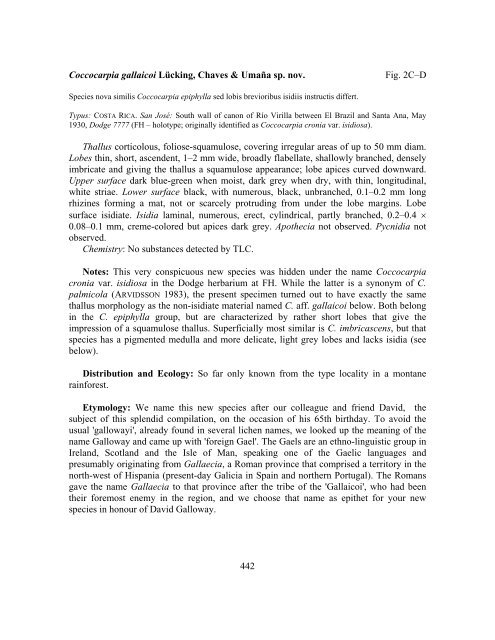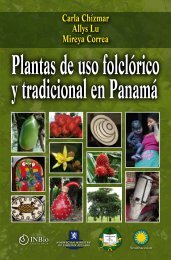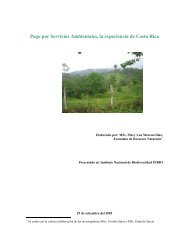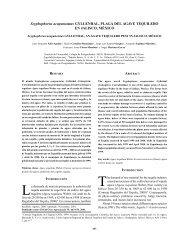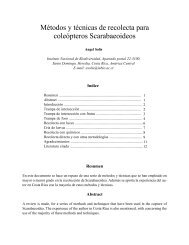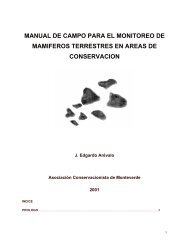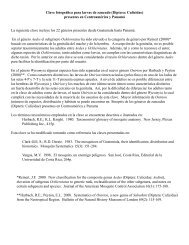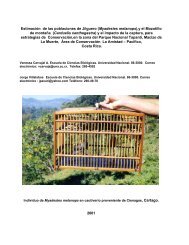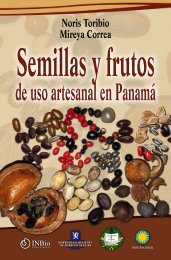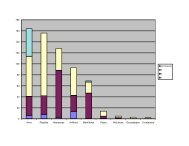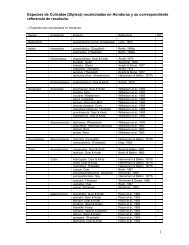the genus Coccocarpia (Peltigerales: Coccocarpiaceae) - Instituto ...
the genus Coccocarpia (Peltigerales: Coccocarpiaceae) - Instituto ...
the genus Coccocarpia (Peltigerales: Coccocarpiaceae) - Instituto ...
You also want an ePaper? Increase the reach of your titles
YUMPU automatically turns print PDFs into web optimized ePapers that Google loves.
<strong>Coccocarpia</strong> gallaicoi Lücking, Chaves & Umaña sp. nov. Fig. 2C–D<br />
Species nova similis <strong>Coccocarpia</strong> epiphylla sed lobis brevioribus isidiis instructis differt.<br />
Typus: COSTA RICA. San José: South wall of canon of Río Virilla between El Brazil and Santa Ana, May<br />
1930, Dodge 7777 (FH – holotype; originally identified as <strong>Coccocarpia</strong> cronia var. isidiosa).<br />
Thallus corticolous, foliose-squamulose, covering irregular areas of up to 50 mm diam.<br />
Lobes thin, short, ascendent, 1–2 mm wide, broadly flabellate, shallowly branched, densely<br />
imbricate and giving <strong>the</strong> thallus a squamulose appearance; lobe apices curved downward.<br />
Upper surface dark blue-green when moist, dark grey when dry, with thin, longitudinal,<br />
white striae. Lower surface black, with numerous, black, unbranched, 0.1–0.2 mm long<br />
rhizines forming a mat, not or scarcely protruding from under <strong>the</strong> lobe margins. Lobe<br />
surface isidiate. Isidia laminal, numerous, erect, cylindrical, partly branched, 0.2–0.4 ×<br />
0.08–0.1 mm, creme-colored but apices dark grey. Apo<strong>the</strong>cia not observed. Pycnidia not<br />
observed.<br />
Chemistry: No substances detected by TLC.<br />
Notes: This very conspicuous new species was hidden under <strong>the</strong> name <strong>Coccocarpia</strong><br />
cronia var. isidiosa in <strong>the</strong> Dodge herbarium at FH. While <strong>the</strong> latter is a synonym of C.<br />
palmicola (ARVIDSSON 1983), <strong>the</strong> present specimen turned out to have exactly <strong>the</strong> same<br />
thallus morphology as <strong>the</strong> non-isidiate material named C. aff. gallaicoi below. Both belong<br />
in <strong>the</strong> C. epiphylla group, but are characterized by ra<strong>the</strong>r short lobes that give <strong>the</strong><br />
impression of a squamulose thallus. Superficially most similar is C. imbricascens, but that<br />
species has a pigmented medulla and more delicate, light grey lobes and lacks isidia (see<br />
below).<br />
Distribution and Ecology: So far only known from <strong>the</strong> type locality in a montane<br />
rainforest.<br />
Etymology: We name this new species after our colleague and friend David, <strong>the</strong><br />
subject of this splendid compilation, on <strong>the</strong> occasion of his 65th birthday. To avoid <strong>the</strong><br />
usual 'gallowayi', already found in several lichen names, we looked up <strong>the</strong> meaning of <strong>the</strong><br />
name Galloway and came up with 'foreign Gael'. The Gaels are an ethno-linguistic group in<br />
Ireland, Scotland and <strong>the</strong> Isle of Man, speaking one of <strong>the</strong> Gaelic languages and<br />
presumably originating from Gallaecia, a Roman province that comprised a territory in <strong>the</strong><br />
north-west of Hispania (present-day Galicia in Spain and nor<strong>the</strong>rn Portugal). The Romans<br />
gave <strong>the</strong> name Gallaecia to that province after <strong>the</strong> tribe of <strong>the</strong> 'Gallaicoi', who had been<br />
<strong>the</strong>ir foremost enemy in <strong>the</strong> region, and we choose that name as epi<strong>the</strong>t for your new<br />
species in honour of David Galloway.<br />
442


